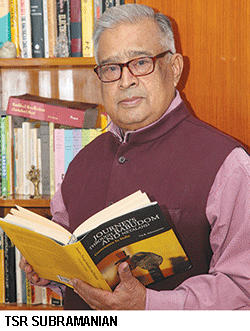Important role of private universities
 India’s higher education system, which includes technical education, is among the largest worldwide. The number of universities has increased from 27 in the 1950s to an estimated 750 today. Simultaneously, the number of colleges and stand-alone institutions has risen equally phenomenally to almost 50,000. Yet it’s not common knowledge that a predominant share of tertiary education capacity has been built by the private sector, which now plays a major role in Indian higher education. But while the number of universities and colleges has risen explosively, the same cannot be said of the quality of higher education, in either the public or private sectors, although there are a few notable exceptions.
India’s higher education system, which includes technical education, is among the largest worldwide. The number of universities has increased from 27 in the 1950s to an estimated 750 today. Simultaneously, the number of colleges and stand-alone institutions has risen equally phenomenally to almost 50,000. Yet it’s not common knowledge that a predominant share of tertiary education capacity has been built by the private sector, which now plays a major role in Indian higher education. But while the number of universities and colleges has risen explosively, the same cannot be said of the quality of higher education, in either the public or private sectors, although there are a few notable exceptions.
The main problem of Indian education is that the government of India is oblivious of the need for new policies for upgradation of the quality of education and research in the country’s institutions of higher learning. With the Central and state governments focussed on the primary-secondary segment, higher education has largely been left to private initiatives. Although this had led to significantly higher enrolments in tertiary education, there’s been an alarming increase in the number of institutions dispensing low-quality education.
Paradoxically, higher education institutions are both under and over-regulated. Nominally, approval for the promotion of private universities has been delegated to state governments which frequently licence new institutions for reasons other than merit. Subsequent monitoring of performance is non-existent, apart from a perfunctory reference to “shall conform to UGC standards” — a mere formality practised more in the breach than compliance. At the same time, the apex-level University Grants Commission is ill-equipped in terms of discipline, competence and reach to monitor the progress or performance of the country’s multiplying higher education institutions, and lacks credibility. This has led to a proliferation of fly-by-night institutions without the competence to provide acceptable quality education.
Nor has a credible system of accreditation of tertiary institutions been evolved or sponsored by government. The attempts of the National Assessment & Accreditation Council (NAAC) over the past years have been perfunctory, sporadic and permeated by lack of expertise. Therefore, in the overall reckoning, the best and good universities and colleges are ranked and bunched with the poor and worst, with equal treatment for all. The best private universities and colleges need greater autonomy and freedom from interference by government, and the worst need to be put on notice, and if non-compliant, forcibly closed down. Unfortunately, these options aren’t exercisable in the current system. It is in this sense that higher education is simultaneously over and under-regulated.
In addition, it’s also substantially true that higher education — indeed education in general — is severely under-funded. Instances of large-hearted private American-style philanthropy are few while profligate Central and state governments haven’t been able to increase their combined outlay for education to 6 percent of GDP, recommended by the Kothari Commission way back in 1967. Therefore the combined government (Centre plus states) expenditure in the public school and higher education sectors is a mere 3.4 percent of GDP. Thus the onus of creating new educational opportunities has fallen on the private sector.
Unfortunately, private edupreneurs haven’t distinguished themselves while discharging this social obligation. A large number of private universities and professional education colleges have been promoted with the ulterior motive of generating black money through levying illegal capitation fees, while scarcely any attention is paid to the quality of education. The result is that the percentage of unemployable graduates of India’s universities, colleges and technical institutions is estimated at over 80 percent by several respectable education research organisations.
The prospects of raising public higher education standards are low because the government is preoccupied with micro-managing a handful of public sector educational institutions, especially the IIMs and IITs. The point to note is that even these institutions are losing their sheen due to diminishing academic autonomy. Indeed, not a single one of India’s nearly 800 universities is ranked in the Top 200 league tables of widely-respected London-based rating agencies QS and Times Higher Education, a damning indictment of India’s higher education system.
The silver lining to the dark cloud over tertiary education is that in recent years, several well-endowed, well-planned and globally benchmarked not-for-profit private universities have become operational. They need to be given official encouragement, freedom to act autonomously on academic issues and to enter into collaborations with foreign institutions of repute. Even if the Central and state governments cannot do much for public universities and colleges, the least they can do is to give greater freedom and ease of doing education to private institutions of proven record and repute.
(T.S.R. Subramanian is a former Union Cabinet secretary and chairman of the Committee for Evolution of the New Policy on Education 2016)















Add comment